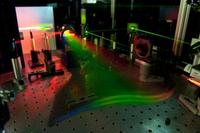-
World's first grid-scale isothermal compressed air energy storage system
A New Hampshire company has completed construction and begun startup of the world’s first megawatt-scale isothermal compressed air energy storage (ICAES) system. The system stores and returns megawatts of electricity to provide long-term grid stability and support integration of renewable energy sources like wind and solar. Unlike chemical battery systems, ICAES performance does not degrade over its lifetime or need frequent replacement. No hazardous materials are used.
-
-
History of explosives highlighted in museum exhibit
For more than seventy years, Los Alamos National Laboratory has been a frontrunner in explosives research, development, and applications. To highlight the Laboratory’s work in the field of explosives, the Bradbury Science Museum is opening a new exhibit, titled “The Science of Explosives.”
-
-
October is National Cybersecurity Awareness Month
This October marks the tenth National Cyber Security Awareness Month (NCSAM), an effort to educate millions of people each year about the importance of online safety and security. During the month, leaders from the public and private sectors will come together to advance its universal theme that protecting the Internet is “Our Shared Responsibility.”
-
-
Sewage treatment removes widely used home and garden insecticides from wastewater
Even though sewage treatment plants are not designed to remove tiny amounts of pesticides, they do an excellent job of dealing with the most widely used family of home and garden insecticides, scientists reported. The use of pyrethrins, derived from chrysanthemum flowers, and the related synthetic pyrethroids, has been on the increase during the last decade. Researchers found that advanced sewage treatment reduced the levels of pyrethroids by more than 97 percent.
-
-
Calculating the cost of a ton of mountaintop removal coal
To meet current U.S. coal demand through surface mining, an area of the Central Appalachians the size of Washington, D.C., would need to be mined every eighty-one days. This is about sixty-eight square miles — or roughly an area equal to ten city blocks mined every hour. A 1-year supply of coal would require converting about 310 square miles of the region’s mountains into surface mines.
-
-
Unified military intelligence picture dispels the fog of war
Military operations depend upon the unimpeded flow of accurate and relevant information to support timely decisions related to battle planning and execution. To address these needs, numerous intelligence systems and technologies have been developed over the past twenty years, but each of these typically provides only a partial picture of the battlefield, and integrating the information has proven to be burdensome and inefficient. DARPA’s Insight program aims to bring real-time, integrated, multi-source intelligence to the battlefield.
-
-
Beer-Sheva Cyber Security Park inaugurated by Prime Minister Benjamin Netanyahu
The development of the Negev took a step forward earlier this month with the inauguration of Beer-Sheva’s Advanced Technologies Park (ATP) in which Ben-Gurion University of the Negev (BGU) is the academic research partner. Israel prime minister Benjamin Netanyahu presided over the ribbon-cutting ceremony on 3 September.
-
-
Canada addresses environmental concerns over Keystone XL
Canadian prime minister Stephen Harper sent a letter to President Barack Obama last month offering to participate in joint efforts to reduce greenhouse-gas emissions in order to win approval of the Keystone XL Pipeline. Harper’s offer may allow Obama to approve the project without having to confront environmental groups.
-
-
Cold-formed steel rebuilds earthquake-resistant architecture
When engineers attempt to make a building earthquake-resistant, they use specific structural components, appropriately called details, to absorb earthquake forces and help direct some of those forces back to the ground. That works, but when an earthquake hits, the entire building reacts, not just the sections containing details. Even though academic research has led to improvements to the original building codes over the decades, there is much to be learned about the entire system of a cold-formed steel building as it responds to an earthquake.
-
-
Calculating the energy required to store wind and solar power on the grid

Renewable energy holds the promise of reducing carbon dioxide emissions. There are times, however, when solar and wind farms generate more electricity than is needed by consumers. Storing that surplus energy in batteries for later use seems like an obvious solution, but a new study from Stanford University suggests that might not always be the case.
-
-
New technique developed to assess the cost of major flood damage
A new approach to calculating the cost of damage caused by flooding was presented at the International Conference of Flood Resilience: Experiences in Asia and Europe which was held last week. The methodology combines information on land use with data on the vulnerability of the area to calculate the cost of both past and future flooding events.
-
-
Bomb-detecting lasers to improve security checkpoints

Research has put the possibility of bomb-detecting lasers at security checkpoints within reach by developing a laser that can detect micro traces of explosive chemicals on clothing and luggage. The laser not only detects the explosive material, but it also provides an image of the chemical’s exact location, even if it’s merely a minute trace on a zipper.
-
-
Researchers fabricate new camouflage coating from squid protein

What can the U.S. military learn from a common squid? A lot about how to hide from enemies, according to researchers. Researchers show that material that mimics calamari skin is invisible to infrared cameras, which is a good thing since infrared detection equipment is employed extensively by military forces for night vision, navigation, surveillance, and targeting.
-
-
“Climate Change, Water Conflicts, and Human Security” report released
Increasingly, climate change and the associated increase in the frequency of extreme weather events such as floods, droughts, and rising sea level, are acknowledged as not only having humanitarian impacts, but also creating national and regional political and security risks. While people and governments can adapt to these impacts, their capacity to do so varies.
-
-
Study links prehistoric climate shift to asteroid or comet impact
For the first time, a dramatic climate shift which has long fascinated scientists has been linked to the impact in Quebec of an asteroid or comet. The event took place about 12,900 years ago, at the beginning of the Younger Dryas period, and marks an abrupt global change to a colder, dryer climate, with far-reaching effects on both animals and humans.
-
More headlines
The long view
New Technology is Keeping the Skies Safe
DHS S&T Baggage, Cargo, and People Screening (BCP) Program develops state-of-the-art screening solutions to help secure airspace, communities, and borders
Factories First: Winning the Drone War Before It Starts
Wars are won by factories before they are won on the battlefield,Martin C. Feldmann writes, noting that the United States lacks the manufacturing depth for the coming drone age. Rectifying this situation “will take far more than procurement tweaks,” Feldmann writes. “It demands a national-level, wartime-scale industrial mobilization.”
How Artificial General Intelligence Could Affect the Rise and Fall of Nations
Visions for potential AGI futures: A new report from RAND aims to stimulate thinking among policymakers about possible impacts of the development of artificial general intelligence (AGI) on geopolitics and the world order.
Smaller Nuclear Reactors Spark Renewed Interest in a Once-Shunned Energy Source
In the past two years, half the states have taken action to promote nuclear power, from creating nuclear task forces to integrating nuclear into long-term energy plans.
Keeping the Lights on with Nuclear Waste: Radiochemistry Transforms Nuclear Waste into Strategic Materials
How UNLV radiochemistry is pioneering the future of energy in the Southwest by salvaging strategic materials from nuclear dumps –and making it safe.
Model Predicts Long-Term Effects of Nuclear Waste on Underground Disposal Systems
The simulations matched results from an underground lab experiment in Switzerland, suggesting modeling could be used to validate the safety of nuclear disposal sites.
